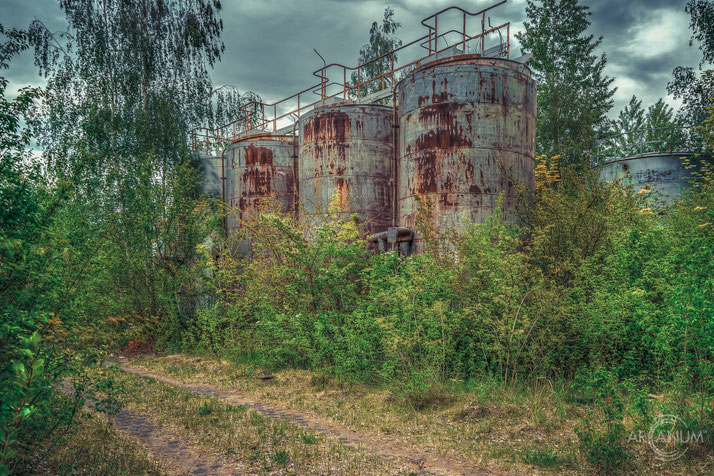Mineral Oil Processing Plant A.
Addinol was the GDR's best-known brand for mineral oil products.
The company still produces automotive oils and lubricants as well as industrial lubricants at other locations and is represented in over 90 countries worldwide.
Until 2000, the production site was the Lützkendorf mineral oil plant near Leuna, which was originally commissioned by Wintershall AG to the "Mitteldeutsche Treibstoff- und Oelwerke A.G. Kassel" and built from October 26, 1936.
With a capacity of 75,000 tons per year, this hydrogenation plant was to
produce various finished and semi-finished synthetic oil products and diesel as a by-product from lignite from December 1938. With a capacity of 75,000 tons per year, this hydrogenation plant was to produce various finished and semi-finished synthetic oil products and diesel as a by-product from lignite from December 1938.
In the four years that followed, additional facilities or extensions were added, including the so-called European tank, which was completed in 1941 and was the largest fuel tank in Europe at the time with a capacity of 20,000 cubic meters. In total, the factory site covered an immense area of 25 km². The overall construction of the plant was not completed until spring 1944 and cost 112 million Reichsmarks.
Aftzer World War II, the Soviet Military Administration in Germany ordered the resumption of production in Lützkendorf on July 12, 1945. Despite the severe war damage, the delivery of the first lubricants to the Soviet Union as reparations began shortly afterwards.
In December 1947, the Soviet Administration ordered the complete dismantling of the rebuilt hydrogenation plant and other production parts. The hydrogenation plant was completely dismantled by mid-1948 and shipped to the Soviet Union, after which the reparations shifted to withdrawals from ongoing production.
After the dismantling, the Soviets allowed the newly founded province of Saxony-Anhalt to buy back the remaining plants in Lützkendorf in stages while simultaneously transferring them to "national property". On July 1, 1948, the plant was incorporated into the "Vereinigung Volkseigener Betriebe" (VVB - Union of People-Owned Enterprises) Kohlenwertstoffe in Halle (Saale) as VEB Mineralölwerk Lützkendorf, Krumpa.
In 1951, the production capacity was 65,000 tons and by 1964, after expansion of the production facilities, the capacity had risen to 250,000 tons of lubricants per year, covering the majority of the GDR's lubricant requirements. At this time, the plant had around 3,600 employees and was the largest lubricating oil manufacturer in the GDR. In 1989, the plant produced 800,000 tons of mineral oil products annually, of which around 300,000 tons were lubricants, and had around 3,800 employees.
In 1989, the year of the beginning of the peaceful revolution in the GDR, the plant's total production amounted to 800,000 tons of mineral oil products. Lubricants accounted for 304,000 tons of this. The price was high: the planned economy left behind a dilapidated fuel plant that could not survive under market economy conditions. What remained were social upheavals and serious contamination of the soil and groundwater - contaminated soil on which, according to experts, "no keen investor would put his money".
The institution for the fiduciary administration of public property, founded on March 1, 1990, separated the VEB Mineralölwerk Lützkendorf, Krumpa from the VEB Hydrierwerk Zeitz on April 30, 1990 and initially assigned the plant directly to the PCK Schwedt as an independent combined operation.
Consultants recommended integrating the Lützkendorf mineral oil plant "into a company familiar with the lubricating oil market by the end of 1992 or, alternatively, shutting it down".
The demolition of the Lützkendorf mineral oil plant began in the fall of 1996.
After the oil plant was shut down, the site was left highly contaminated with toxic substances. A tar lake with 110,000 tons of deposited acid resins and bleaching earth was remediated by 2003. BP built a solar park on part of the former plant site, which was the largest in Europe at the time with around 25,000 solar modules when it was completed in 2004.
Due to the advanced spread of pollutants and the complicated geological conditions, large areas of the site had to be left to natural degradation. The groundwater flow from the former plant site towards the near lake Geiseltalsee was stopped by a concrete wall around 40 meters deep and 800 meters long.
Geologists assume that the process of "self-healing" by bacteria will take decades or even centuries due to the high concentration of pollutants. At the end of 2009, the Saxony-Anhalt State Office for Environmental Protection stated that "a mineral oil well could still be opened today" on the highly contaminated site.
In 2017, there were still 25 oil tanks in various sizes with capacities of 2000, 1000, 160, 100 and 35 cubic meters.
Source: Wikipedia
Visited: May 19, 2020 and August 26, 2022
Location: Krumpa, Germany
Status: Abandoned




































